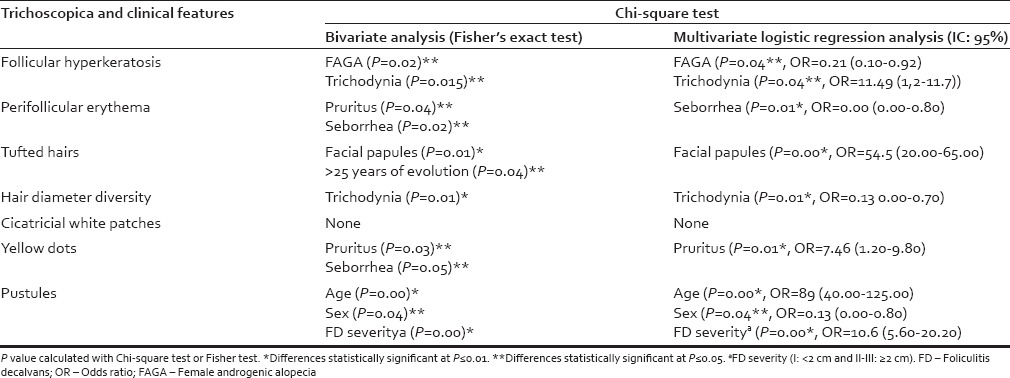Sir,
Folliculitis decalvans (FD) of Quinquaud is a rare form of neutrophilic scarring alopecia that presents with scarring alopecic patches with follicular pustules, crusts, and tufted hairs.[1] The main objective of our study was to describe the trichoscopic features of FD in a large series of patients and correlate them with several relevant clinical parameters.[2] For this purpose, we performed a descriptive, retrospective, observational, and multicenter study that included the digital trichoscopic images of 58 patients diagnosed with FD between 2001 and 2014 in 12 Spanish centers.[2] The diagnosis of FD was established based on typical clinical and dermoscopic findings together with histopathologic confirmation in all cases. Clinical aspects and severity variables included were FD severity (I–II: <4.99 cm of maximum diameter of the scarring patch and III: 5 cm or more) and years of evolution, previous trauma, pruritus, trichodynia, tufted hairs, pustules, seborrhea, and facial papules. Both a descriptive and an analytic study to correlate these parameters with the degree of severity and other clinical variables were performed using SPSS 15.0® (SPSS 15.0 IBM, IBM Corporation, 1 New Orchard Road, Armonk, New York). The most frequent trichoscopic features are described in Table 1. Bivariate and multivariate logistic regression analysis adjusting by age and sex were carried out [Table 2]. Both the intraobserver and interobserver agreement for the assignment of a dermoscopic pattern for each lesion were excellent (κ = 0.7, P < 0.001, and κ = 0.75, P < 0.001, respectively).
Table 1.
Frequency of trichoscopic features of patients diagnosed with folliculitis decalvans

Table 2.
Trichoscopic features that evidenced association with some clinical parameters with statistical significance (P<0.05) in the bivariate and multivariate logistic regression analysis

We found that 95.3% of patients with mild severity presented tufted hairs, 86% perifollicular erythema, and 69.8% follicular hyperkeratosis. On the other hand, 93.3% of patients with severe FD presented perifollicular erythema, followed by tufted hairs in 86% of cases and follicular hyperkeratosis in 80%. Although we found tufted hairs frequently, we cannot conclude that is a pathognomonic tricoscopic sign of FD.[3] No statistical association was found between the disease severity and trichoscopic findings but was positive with the presence of pustules, in concordance with the published series of Vañó-Galván et al.[2] We also evidenced association with statistical significance (P < 0.05) between pruritus and patients with a history of FD of more than 25 years of evolution (P = 0.01). It is not known whether the higher incidence of trichodynia in the alopecia patients is due to a pathologic alteration of sensorial perception or to somatization of the anxiety and depression associated with hair loss.[4] Remarkably, we found that the presence of follicular hyperkeratosis and hair diameter diversity were statistically associated to trichodynia in multivariate test. The presence of yellow dots was related with statistical significance (P < 0.05) with pruritus and those patients with tufted hairs presented more frequently facial papules.
The main limitations are the small number of cases, the retrospective design, the presence of only two observers, and the fact that neither the alopecia's treatment nor the activity of the disease was included in the analysis.
In conclusion, tufted hairs, perifollicular erythema, and follicular hyperkeratosis are the hallmarks trichoscopic features of FD. Patients with trichodynia presented follicular hyperkeratosis and hair diameter diversity. The presence of pustules could be a marker of severity and activity of FD.
Financial support and sponsorship
Nil.
Conflicts of interest
There are no conflicts of interest.
REFERENCES
- 1.Powell JJ, Dawber RP, Gatter K. Folliculitis decalvans including tufted folliculitis: Clinical, histological and therapeutic findings. Br J Dermatol. 1999;140:328–33. doi: 10.1046/j.1365-2133.1999.02675.x. [DOI] [PubMed] [Google Scholar]
- 2.Vañó-Galván S, Molina-Ruiz AM, Fernández-Crehuet P, Rodrigues-Barata AR, Arias-Santiago S, Serrano-Falcón C, et al. Folliculitis decalvans: A multicentre review of 82 patients. J Eur Acad Dermatol Venereol. 2015;29:1750–7. doi: 10.1111/jdv.12993. [DOI] [PubMed] [Google Scholar]
- 3.Powell J, Dawber RP. Folliculitis decalvans and tufted folliculitis are specific infective diseases that may lead to scarring, but are not a subset of central centrifugal scarring alopecia. Arch Dermatol. 2001;137:373–4. [PubMed] [Google Scholar]
- 4.Kivanç-Altunay I, Savas C, Gökdemir G, Köslü A, Ayaydin EB. The presence of trichodynia in patients with telogen effluvium and androgenetic alopecia. Int J Dermatol. 2003;42:691–3. doi: 10.1046/j.1365-4362.2003.01847.x. [DOI] [PubMed] [Google Scholar]


